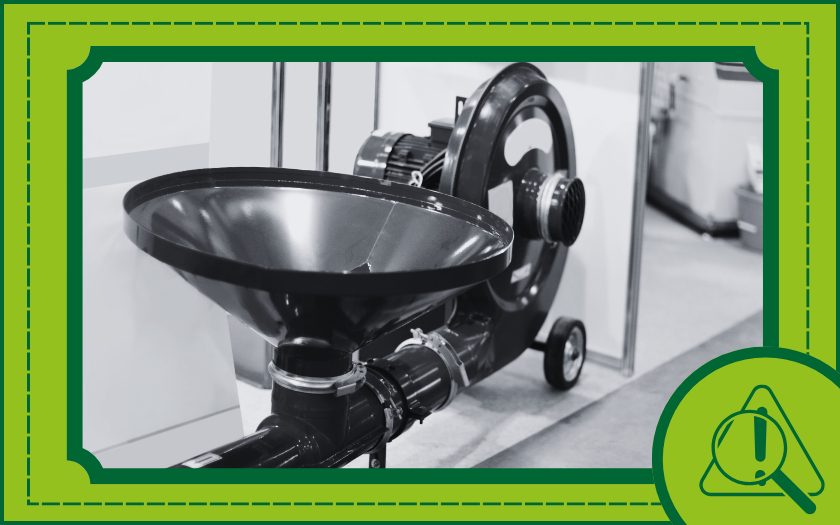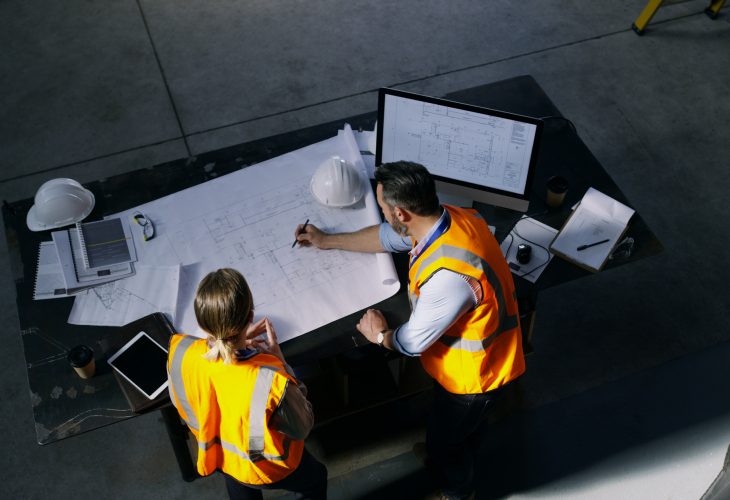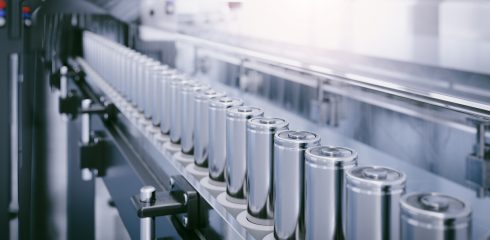
Pneumatic conveying systems use gas, like air, nitrogen, or argon, to transport bulk solid materials through enclosed pipelines or ductwork. This makes them well-suited to operations that handle dry bulk solids with tight cleanliness standards, long routing distances, or space-limited layouts and configurations that require relatively complex routing with multiple bends or turns that cannot be accomplished through other means of conveyance.
Whether transporting fine powders in a battery manufacturing line or resin pellets in a plastics facility, pneumatic conveyors offer a streamlined alternative to open mechanical systems and can be routed through tight, multi-level layouts with ease. The reliability of a pneumatic conveyor, however, is determined by the adequacy of the system’s design, as well as how effectively the design parameters and operating conditions align with the physical properties of the material being conveyed. When that compatibility breaks down, issues such as frequent blockages, unstable flow, particle degradation or attrition, and premature wear can appear. Fixing these problems requires knowledge of where and why the system is underperforming, then applying the right solution with precision.
Defining Pneumatic Conveying Systems
At their core, pneumatic conveying systems use air (or other gases) at moderate to high velocity to provide a drag force to push or pull a dry bulk material through pipelines, rather than relying on purely mechanical means for material transport like belt or screw conveyors.
Pneumatic conveyors are often preferred over mechanical systems due to their typically lower capital expenditure and reduced maintenance needs, owing to fewer moving parts. They also offer greater design flexibility, making it easier to integrate multiple feed, pickup, and delivery points. This adaptability extends to leveraging existing pipe racks and accommodating complex routing including vertical and horizontal runs, long transport distances, and multiple turns within a single system.
Every pneumatic conveying system is classified by its conveying mode:
- Dilute phase conveying: High-velocity, low-pressure airflow keeps particles fully suspended in the gas stream. It’s generally best suited to materials that are not sticky and cohesive, highly abrasive, or prone to particle damage. Nearly all materials can be conveyed in dilute phase full suspension transport.
- Dense phase conveying: Low-velocity, high-pressure airflow moves materials through the line in a partially suspended state, either as compact slugs or as moving beds or dunes. This mode offers a gentler approach for handling fragile or abrasive solids and can also deliver higher capacities over longer distances compared to dilute phase transport. However, dense phase systems aren’t suitable for all materials. They tend to be more sensitive than dilute phase systems to variations in material characteristics, including changes in feedstock or issues like particle segregation and flow inconsistency.
Another way of classifying pneumatic conveying systems is by pressure mode, based on whether they operate using positive pressure or negative pressure, such as vacuum conveying. Positive pressure systems are better suited to higher capacities and longer conveying distances, and they also allow for the use of inert gases. Vacuum systems, on the other hand, are ideal for when dust containment is critical, since any leakage draws air inward. This makes them perfect for handling toxic or hazardous materials.
To ensure a pneumatic conveying system can operate reliably and effectively, its system design must align with a material’s flow behavior, sensitivity, and process demands. Without such compatibility, even a well-built system can struggle to perform as intended.
Standard Issues in Pneumatic Conveyors and How to Fix Them
While pneumatic conveyors are efficient and adaptable and offer a variety of advantages over other conveying technologies, from lower maintenance requirements to flexible routing, they’re certainly not immune to performance issues. Several problems can occur if the pneumatic conveying system isn’t designed properly or matched to the material or its process conditions.
1. Line Blockages
Blockages in pneumatic conveyors often begin as air velocity drops below the level needed to keep particles suspended, or when the particles lose too much momentum as a result of impacts at elbows or bends. Material then begins to settle, gradually building up until it obstructs the pipeline. This is common with sticky powders that absorb moisture or tend to compact, and in layouts with significant numbers of bends that make it harder to maintain sufficient particle momentum. Such conditions result in an unstable flow environment that hinders consistent conveying.
Potential fix strategies:
- Reduce the number of bends
- Replace tight or short-radius elbows with long-radius bends (unless wear is a concern)
- Increase air velocity through resizing blowers or adjusting dampers
- Install air boosters along horizontal sections or other high-resistance areas of the pipeline
2. Material Degradation
Friable or brittle materials are particularly susceptible to particle damage and fines generation in pneumatic systems due to the extremely high velocities and kinetic energy required. These conditions often generate energetic collisions with pipe walls and fittings, which frequently lead to particle breakage. This is especially true for dilute phase full-suspension systems that operate at much higher velocities, typically 2 – 5 times higher than dense phase systems. If particle breakage occurs, the resulting fines can reduce product consistency, contribute to dust accumulation at the receiver, complicate downstream processing where uniform particle size is essential, and make flow stoppages in downstream equipment far more likely, as finer materials tend to be more difficult to handle than coarser materials.
Potential fix strategies:
- Use mechanical conveyance rather than pneumatic transport because mechanical conveying doesn’t have as much kinetic energy that can cause particle breakage
- Reduce conveying velocity as much as possible to minimize impact energy
- Consider using dense phase rather than dilute phase transport if the materials are suitable
- Apply long-radius bends rather than short-radius bends to lower impact-related damage to the material
3. Pipeline Wear
Pipeline wear is a standard concern for pneumatic conveyors that handle abrasive materials. Research has shown that, much like particle breakage, abrasive wear can increase at velocities of 3,000 feet per minute or higher. High-speed particles can erode the internal surfaces of pipes, causing leaks, contamination, and increased maintenance. Excessive wear frequently arises from system layouts with repeated directional changes or from using components made of materials not suited to abrasive conditions.
Potential fix strategies:
- Utilize abrasion-resistant materials like hardened steel or ceramic in high-wear areas, typically at the elbows
- Optimize the pipeline layout to reduce directional changes and impact zones
- Lower transport velocity as much as possible and consider switching to dense phase if appropriate for the material
4. Inconsistent Material Flow
Materials prone to poor flow or segregation can cause surging, batch inconsistencies, or partial conveying cycles in pneumatic conveyors. These irregularities often stem from feeder design flaws, hopper bridging, or mismatches between feeding rate and conveying conditions.
Potential fix strategies:
- Ensure the upstream hoppers and feeders are properly designed to establish uniform, consistent mass flow discharge
- Check that any gas leakage from the pipeline is not causing issues in the hoppers or feeders upstream
- Watch for and address material buildup or slugs or material in the conveying line, which can cause conveying line pressure fluctuations
- Confirm that the filter or receiver designs prevent filter blinding
- Integrate feed control with pressure and airflow monitoring for real-time adjustment
5. Product Contamination
Properly-designed pneumatic conveying systems can enable essentially complete pipeline cleanout, making them far less prone to product cross-contamination issues than mechanical conveyors like screws, which typically have a layer of residual material at the bottom of the trough and cannot provide complete cleanout without disassembling the conveyor. However, if the pneumatic conveying system is not properly designed, product contamination can regularly pose a significant challenge, especially across industries that enforce strict quality standards such as pharmaceuticals and food processing. Poor sealing, dead zones within pipelines, and ineffective cleaning between batches or product changeovers can allow residual materials to accumulate or mix, leading to product cross-contamination, batch rejection, and regulatory issues.
Potential fix strategies:
- Make sure the system is designed to eliminate buildup and dead material within the pipeline
- Implement Clean-In-Place (CIP) or air purging systems between production runs
- Upgrade seals, gaskets, and airlocks to meet hygienic design standards
- Apply dedicated lines or automated diverter valves for multi-product handling
Be aware that all these potential fix strategies are very dependent on the material being conveyed and the equipment being used in the field.
Expert Solutions for Pneumatic Conveying
Pneumatic conveyors are crucial for efficient bulk material handling but commonly experience issues like blockages, wear, and contamination that impact productivity. Here at Jenike & Johanson, we use our extensive materials expertise and advanced testing to design tailored, reliable systems that prevent these issues. From upgrades to new installations, our solutions help ensure smooth, uninterrupted operations. Contact us today to see how our pneumatic conveying expertise and services can improve your process performance.





